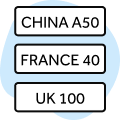Our pricing
At OANDA we offer two pricing options: spread-only and commission plus core spread. Our pricing models are clear and transparent. You can choose to pay the spread with our spread-only pricing option or access lower spreads with our commissions model.


Spread-only pricing
With this account type, our commission is wrapped into the spread we offer so the spread is the only cost you pay.
Commission + core spread pricing
Access a reduced spread relative to our spread-only pricing account. You only pay a fixed commission per trade. The total cost for each trade will be the sum of the applicable core spread plus commission. We offer competitive core pricing spreads.
How our pricing is derived
Our pricing is derived from:
- Forex and metals: liquidity providers
- Commodities and copper: a combination of relevant futures prices (‘near’ and ‘far’ contracts)
- Indices: a combination of the relevant futures price, as well as a theoretical fair value adjustment to account for the effects of interest rates, dividends and time to expiry of the underlying future’s contract price.
Your orders are filled at our best available price.
Commission + Core pricing vs spread only
Compare pricing on our most popular FX pairs, with spreads from:
| FX pair | Spread only | Core pricing |
|---|---|---|
| AUD/USD | 1.1 | |
| EUR/GBP | 1.1 | |
| EUR/JPY | 1.6 | |
| EUR/USD | 1 | |
| GBP/JPY | 1 | |
| GBP/USD | 1.2 | |
| NZD/USD | 1.4 | |
| USD/CAD | 1.5 | |
| USD/CHF | 1.3 | |
| USD/JPY | 1.1 |
Forex and metals CFDs
Our pricing for forex and metals CFDs is derived from our liquidity providers - major financial institutions who provide us with available spot pricing for FX pairs and metals. Different groups of liquidity providers are used to derive pricing for different products/instruments.
Indices CFDs
Our pricing for our indices CFDs is calculated by reference to a combination of the relevant futures prices and the ‘cash’ or ‘spot’ prices, in respect of the underlying instrument.
Adjustments are made such as adding our own spread, adjusting for liquidity in external markets, currency exchange rate differentials and other relevant factors. Adjustments may also be made to reflect market movement following the payment of dividends and other anticipated corporate actions.
Commodities and copper CFDs
The prices of our commodity (including copper) CFDs are based on underlying futures contracts. When an underlying futures contract is near expiry, we calculate the basis rate, which represents the difference in price between the expiring futures contract and the next futures contract.
From that point forward, our CFD price is calculated as the present value of the price of the next futures contract, using the basis rate for the present value calculation. The present value is calculated continuously, second-by-second.
When the basis rate is positive, the CFD price will tend to move upwards towards the contract price. When the basis rate is negative, the CFD price will tend to move downwards towards the contract price.
Ready to start trading? Open an account in minutes
Already have a live trading account? It's easy to fund your account using one of the following payment methods.






Frequently asked questions
What are financing costs?
Find out how financing costs are calculated.
What is a corporate action?
Constituent stocks of an index will periodically pay dividends to shareholders. When they do, this impacts the overall price of the index, causing it to drop by a certain amount. We may make dividend adjustments if a dividend is scheduled to be paid to the holders of the underlying instrument. These adjustments are normally made on the ex-dividend date.
How would dividend adjustments work on open positions of index CFDs?
When there’s a dividend payment, this is normally reflected in the index CFD price. If you have an open position at the time of a dividend adjustment, we’ll ensure that there is no material impact on you by either crediting or debiting your account with the same amount that your unrealised profit and loss has been impacted.
For example:
Long positions:
Let’s assume UK100 (FTSE) is trading at 7,167.95 GBP. If you are long 20 units of UK 100 and a stock in the index pays out a dividend that equates to five index points.
The index value would drop to 7162.95 GBP.
The dividend adjustment would be
= index dividend points X no. of units of the index CFD held
= 5 X 20 = 100 GBP
This will be credited to your account post home currency conversion.
Short positions:
Let’s assume US SPX 500 (S&P500) is trading at 2,989.69 USD. If you are short 10 units and a stock in the index pays out a dividend that equates to 0.890 of index points.
The dividend adjustment would be
= Index dividend points X no. of units of the index CFD held
= 0.890 X 10 = 8.90 USD
This will be debited from your account post home currency conversion.
You will be able to see OANDA's dividend adjustments on your transaction history and statements.
Can’t find what you’re looking for?
Trade forex CFDs
Trade CFDs on 48 forex pairs, with competitive spreads. Take a position using the MetaTrader 4 and 5 platforms.
What are financing costs?
Financing costs can affect your cost of trading, so it's important to understand how financing works.
Our spreads and margins
We offer attractive spreads across our full range of CFD markets.




